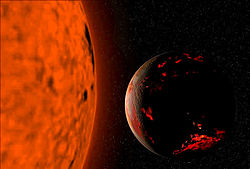
Image of what Earth may look like 5-7 billion years from now, when the Sun swells and becomes a Red Giant. by Fsgregs
After the sun puffed up into a red giant a few billion years ahead of schedule, making a cinder out of the Earth, a glowing red wasteland of Mars, turning Jupiter into a cloud of methane and ammonia gasses making all the bovine flatulence ever emitted insignificant in a way usually reserved for comparisons involving astronomical distances and national debts, stripped the rings off Saturn faster than a Estonian mail order bride after the inevitable divorce, and turned Neptune in a giant toasted marshmallow (the less said abut the fate of Uranus, the better), suddenly the most habitable place in the solar system was poor deplaneted Pluto.
So humankind hunkerd down on its no longer quite so frozen surface and settled in for a long winters night.
The new Plutonians, seeded from a pitiful few science types who’d been out in the black too long, loved geeky irony, so nothing would do but to name the settlement, which eventually became a fair sized metropolis, after the man who had dismissed Pluto from the planetary ranks in the first place. Old wounds and memories fade though, and by the time the generations born on Earth had gone to feed the worms in the city’s central park and gone from worms to soil, and thence to pushing up daisies, visitors had quite forgotten why it was the custom to kneel in the grass of Tyson.
Actually, there’s a fairly stiff fine for explaining it.
Note: I spared no effort in not researching any of the astronomical points here, despite that, I came across an interesting piece in Astrobiology magazine titled, “Delayed Gratification Zones” which points out that during the Sun’s red giant phase, due i about 5 billion years, the solar system’s habitable zone will move out to beyond Pluto. Go figure.